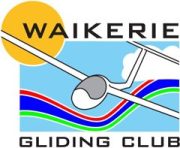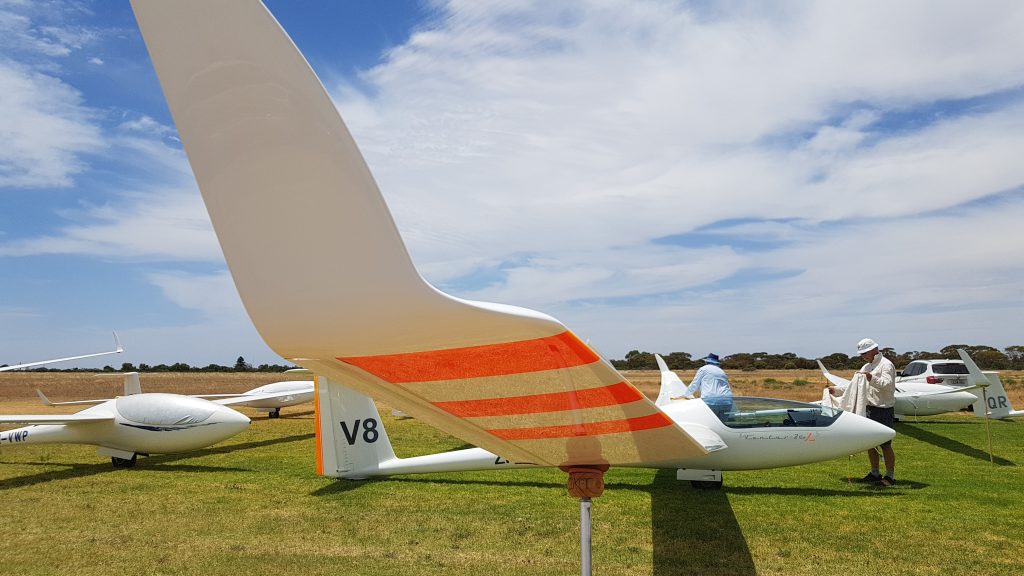I started this article before seeing Craig’s a great article on the contest in Gliding
Australia, but I thought that I would still persist for the club website to give
another insight.
In summary, a great and incident free contest, with just three (I think?) paddock
landings
As I noted in my earlier Gawler GP report, contest numbers are still suffering
from a series of circumstances including, I believe, COVID aftermath, Inflation,
Ageing pilot demographic, and inertia of perhaps lessening interest?
Notwithstanding we still had a great, highly competitive, contest in two classes.
Organisers decided to simply run two contest classes – Open and Sports. The
Open Class had 4 past national champions, including one word champion, in a
field of 11 and the Sports class 1 past national champion in a field of 6. The
Sports class almost didn’t happen but with Rod van den Brink getting the ball
rolling and Sid Nankivell committing, President Craig got onto the hustings and
we soon had a quorum. Well done Craig!
When the idea of the Nationals being held at Waikerie was first muted, there was
some hesitancy regarding human resource to run it. We should not have worried.
With reduced contest numbers, a good run of weather, and a great camaraderie
amongst contestants, organisers and supporters it ran on rails. Perhaps there
was a bit of duck happening – smooth on the surface and a bit of pedalling below.
Thanks to Rodney vdB and Adam Howell, the website was up and running in
good time to encourage potential contestants.
A couple of days before the contest it all fell into place. Fresh from the Gawler
GP Team Temple (Mandy and Pete) along with Bill Mudge, Mathew Scutter and
Craig established the contest on a very even keel. Mandy was contest director,
supported by contest steward Anita Kauffman. Pete along with weather input
from Mathew did the task setting. And as it turned out, the weather provided a
few tricky bits with sometimes short windows and late starts. Pete and Mathew
managed to extract the best out of each day resulting in some pretty exciting
flying ranging from scaping around low in the blue, nervous glides in the lee of
the flooded Renmark Loxton Kingston triangle, belting along under high based
cumulus and racing back to Waikerie to beat a South Westerly dust laden squall.
As usual the Waikerie members and friends rallied to support the competition.
Craig and Bill did a lot of the legwork, updated turnpoint files and pilot briefing
notes were produced, the clubhouse and rooms readied etc. Noting that the
coaching week was a couple of weeks before the contest had members and
volunteers pretty busy in support of both events. We had the luxury of Jason
and Sandy Goldup who manned the kitchen and provide us with an excellent
range of generous meals during both events..
Contest admin is not particularly visible but there is a lot of activity in this space
and was seamlessly managed by Bill Mudge and Lynley Jones. Registration was
done electronically; so on arrival scrutineering was the only formality. The
scrutineering police, John Ridge and David Jones checking weights, equipment fit,
maintenance releases etc, were most accommodating with their time in getting
all pilots through the process with no “blueys” issued.
One of the characteristics of non-GP contest flying has been the start procedure,
where, after the gate is opened, pilots start whenever they wish. This has
always been somewhat problematic, with pilots wanting most of the field to start
ahead of them so that they would have thermal markers ahead and then be able
to run them down. The result often was pre-start shenanigans with everyone
waiting for everyone else to start, often after the obviously best time to start. In
addition, there were pilots who would wait until a top pilot started and then
follow them and then stick with him to improve their own results. This was
referred to as ’leeching’. Whilst leeching is a legitimate tactic – there are no rules
against it – the fast pilots were annoyed by it and often the leechers ended up
with resulting higher scores, which did not really reflect their true skill level.
Furthermore, this start system often resulted in the formation of big gaggles out
of the start gate and on task, particularly if it were a blue day. Accordingly a
number of start procedures have been considered in order to reduce leeching
and reduce gaggling.
At Waikerie the start procedure (for the open class only) was in line with recent
international practice whereas pilots needed to commit to starting in a window
that they created prior to start. Pilots would initiate a pilot event marker (PEV)
via their logger system, which would place a ‘marker’ on their log file for
verification. At Waikerie the window was from 10 minutes to 20 minutes after
creating the marker. IE once you pressed the marker you had to go through the
gate between 10 and 20 minutes later. Since pilots did not know others
windows’ this made leeching more difficult and reduced the likelihood of a group
start.
To execute the PEV process, some pilots elected to set up and use their nav
systems (LX 9000 / Oudie) to assist, but I found that simply using my watch and
noting the 10 and 20 minute time was very easy and simple. Of course I had to
remember the times!!!!
From my perspective it is a positive step to reducing leaching and gaggling but
adds an additional challenge trying to predict your circumstance 10 minutes
ahead until your window opens. But that is glider racing………… It certainly
encourages individual decision making as to when to start. I thought that it
worked well at Waikerie.
OK, so a typical day was get up, have breakfast etc, prepare the glider and attend
the brief at 10am for domestics, safety, weather and task. Since most days had
predicted relatively late starts the flight preparation and tow out was a
reasonably leisurely affair. John Ridge looked after ground operations and we
had to run the gauntlet of the weighing team of David Jones and John, later
supported by Alana Jones and Patrick Dunn where all gliders were weighed to
ensure no one had overfilled. Since all aircraft were being weighed, there was
no penalty if one had inadvertently taken on a bit too much to drink, with excess
water simply dumped until the correct weight achieved. This happened on the
odd occasion, but in general all pilots managed to roll through at, or
underweight.
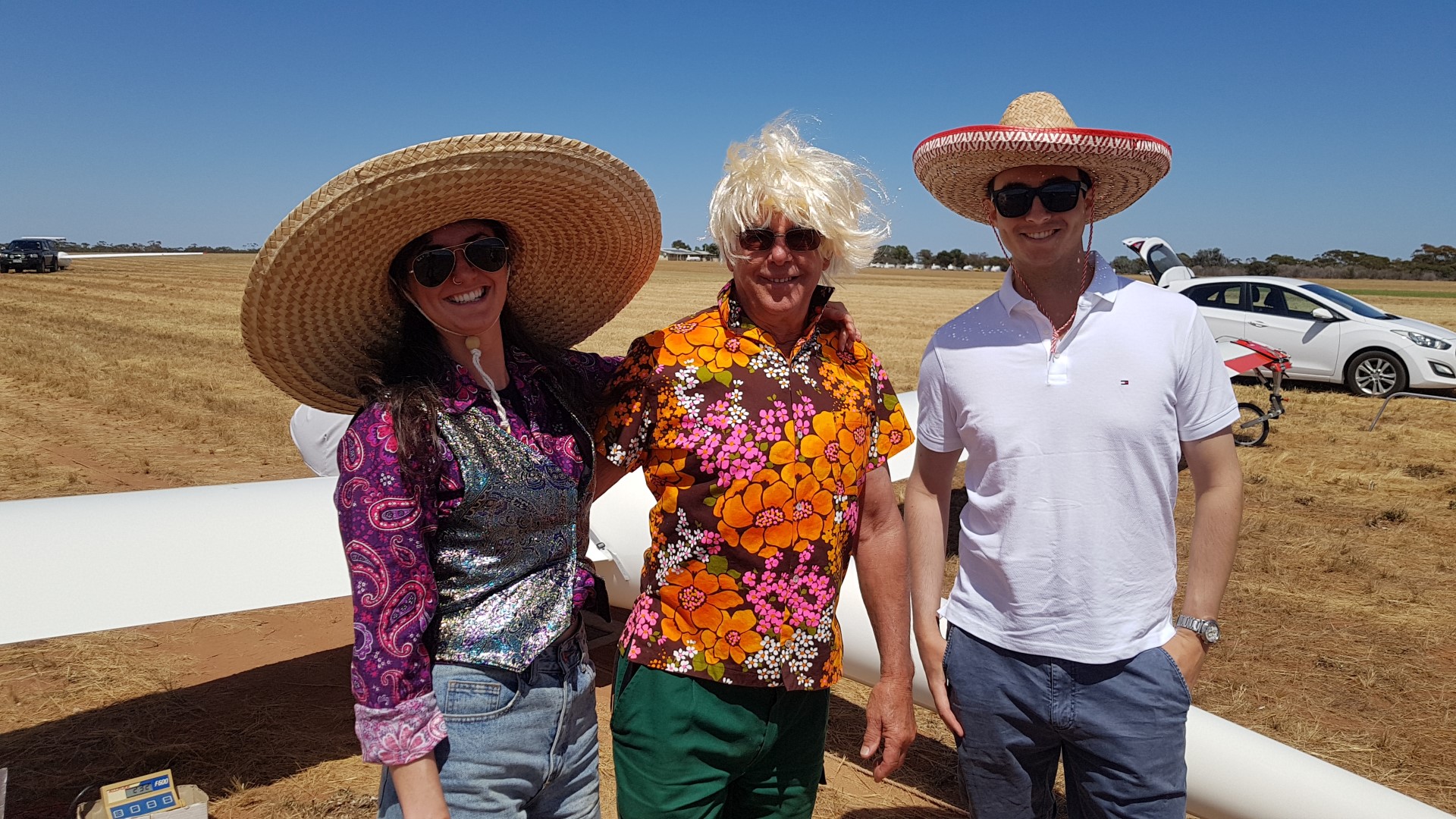
Gridding always put the open class at the back. With the flooding of the
normally dry lagoons a launch failure at just the wrong moment would give the
pilots no option but a water landing. Bill, who was in charge of flight
operations, kept a close eye on the launches and always breathed a sight of relief
when each launching glider safely transited the few seconds where the water
was the only option for the glider pilot. Having the heavier (600kg) open class
at the back gave just a tiny bit more height and a slightly shorter ‘no option but
the water landing’ period. The tug pilot often had (has) nastier options and
hopefully the weight of the engine and the cockpit roll cage would provide
adequate protection. It is easy for glider pilots to forget that with an engine
failure the tug pilot’s options are really limited which, from low altitude, is
simply look up to 30 degrees each way and pick the least risky point to crash.
We had up to three tugs for launching with Lloyd managing that end of the rope.
Many thanks to the pilots from the Adelaide Soaring Club and Adelaide
University Gliding club for their aircraft and pilots. In addition to tugmaster
Lloyd Baum flying our tug, John Stobie flew the AUGC tug VH-HZY and the ASC
tug was flown by Ali Swart and our GFA President, Steve Pegler. David Conway
filed in on occasion. Thanks Guys.
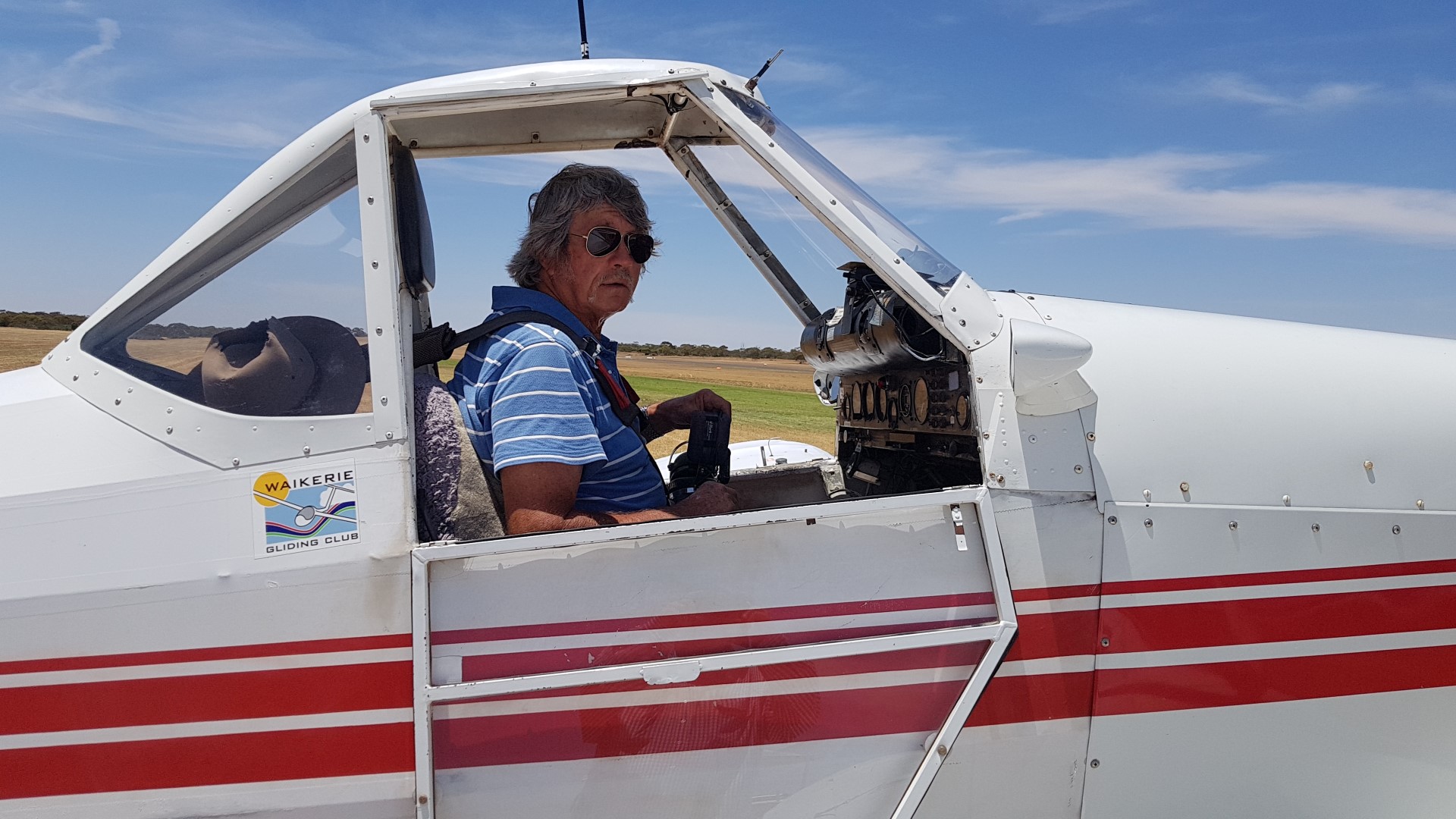
Lynley Jones and Lyn Spencer-Cole looked after the essential task of
Timekeeping to keep track of contestants, particularly important in the event of
outlandings with late check-ins.
Keith Willis in the mighty PW5 did the thermal ‘sniffing’. With the late starting
and perhaps uncertain soaring conditions the idea here was to test the
conditions to ensure that competitors were able to stay airborne once launched.
This worked extremely well but we tested Keith’s enthusiasm for the task when
he was unable to stay airborne on occasion and we risked his amazing track
record for average flight time of greater than five hours in the PW5! Thank you
Keith.

Once launched and before start proved quite interesting on a couple of days. On
a couple of days immediately post launch we had to be careful just to stay
airborne, even though the forecast had been for better.
On day one I needed to start the donk in the circuit to avoid a relight, as did at
least one other pilot. Interestingly, having flown for so many years without the
donk I was on downwind to land when I thought………“hang on I can use the
engine here”!!! Once established in weak lift I could see high-based cumulus
just out of reach north of the river. It became a waiting game to get sufficient
height to commit across. Eventually after about half an hour I made the run and
the reward was a 5-8kt climb to just under 11,000ft.
Executing the start process was pretty simple. Just press the PEV on each of the
data recorders, look at my watch, and start within 10 to 20 minutes. This had
the effect of not worrying too much about when others might start because once
pressing the PEVs I was committed to that window or I would have to wait at
least 20 minutes before I could go through the start again.
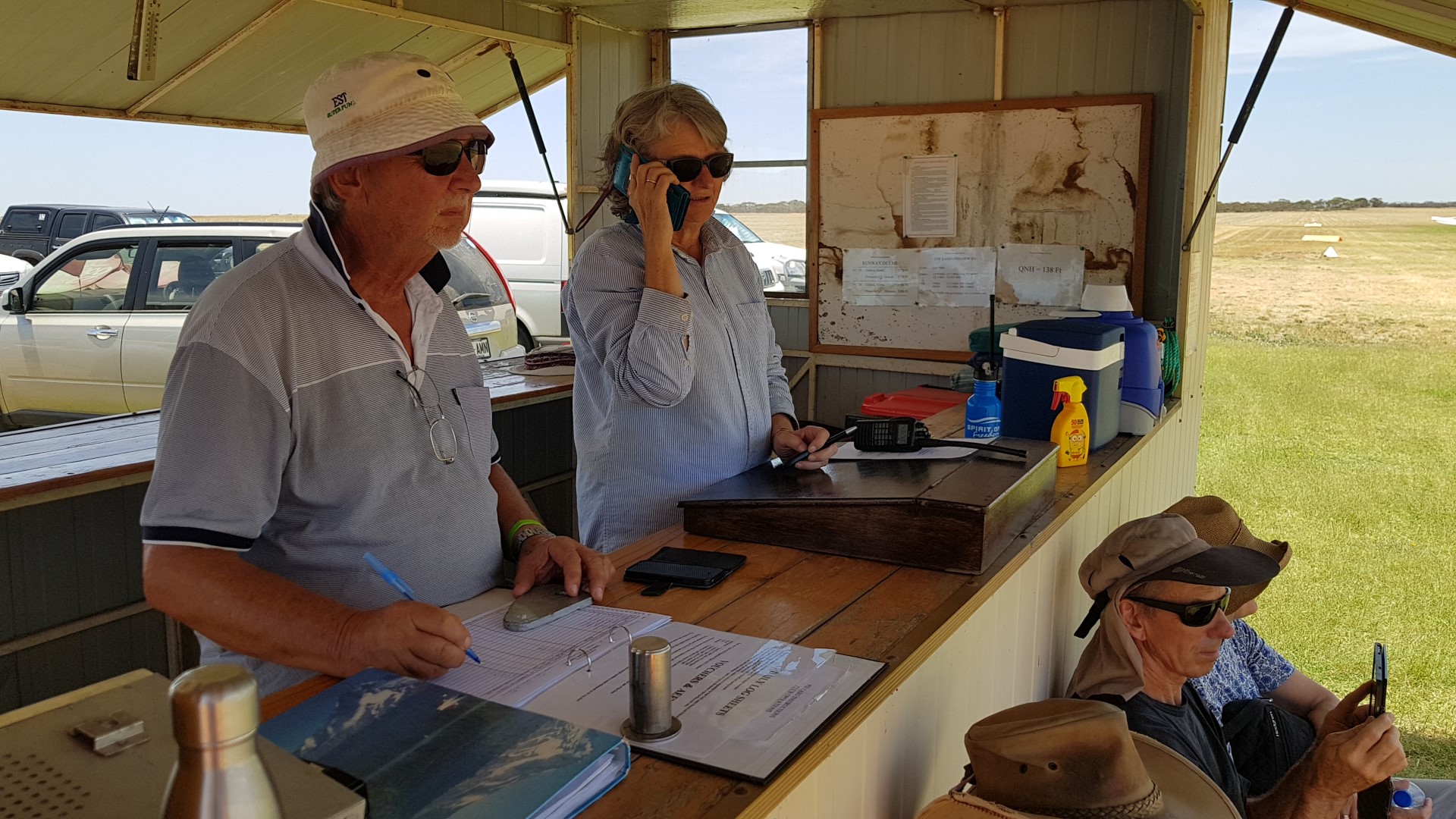
I will not describe each day in detail, Craig has given a good overview in the
Gliding Australia magazine and for those that are interested, Mathew Scutter,
Bruce Taylor and Adam Wooley have given great descriptions on their respective
Facebook pages. I will however share a few of my high (low?) lights in the
Open/18M Class.
Back to Day One: After the initial struggle mentioned earlier, we were been
blessed with high cumulus and excellent energy lines. Just 3 climbs and a few
random circles to fly 303km at 159kph! Craig flew fastest with a raw speed at
165kph. Quick!!!!
Day Two: The forecast didn’t eventuate and we found ourselves at Lindsay River
at about 4,500ft with a long very smooth glide across Renmark in the lee of the
flooded area. Most of the class were there and we worked every bit of weak lift
tip toeing forward not wanting to be out front. Better to be a little slow than
going for it and landing in a paddock! Eventually about half of the field made it
with one paddock landing and four engine starts.
Day Five: This was a tricky one for Pete and Mathew to task. A front was
approaching from the west and expected to hit Waikerie in the mid afternoon
with a vengeance. An Assigned Area Task with a narrow wedge into the west to
connect with the approaching trough line then back to a large circle centred on
Meribah and home via Woolpunda. I should have paid more attention to the
Skysight convergence forecast.
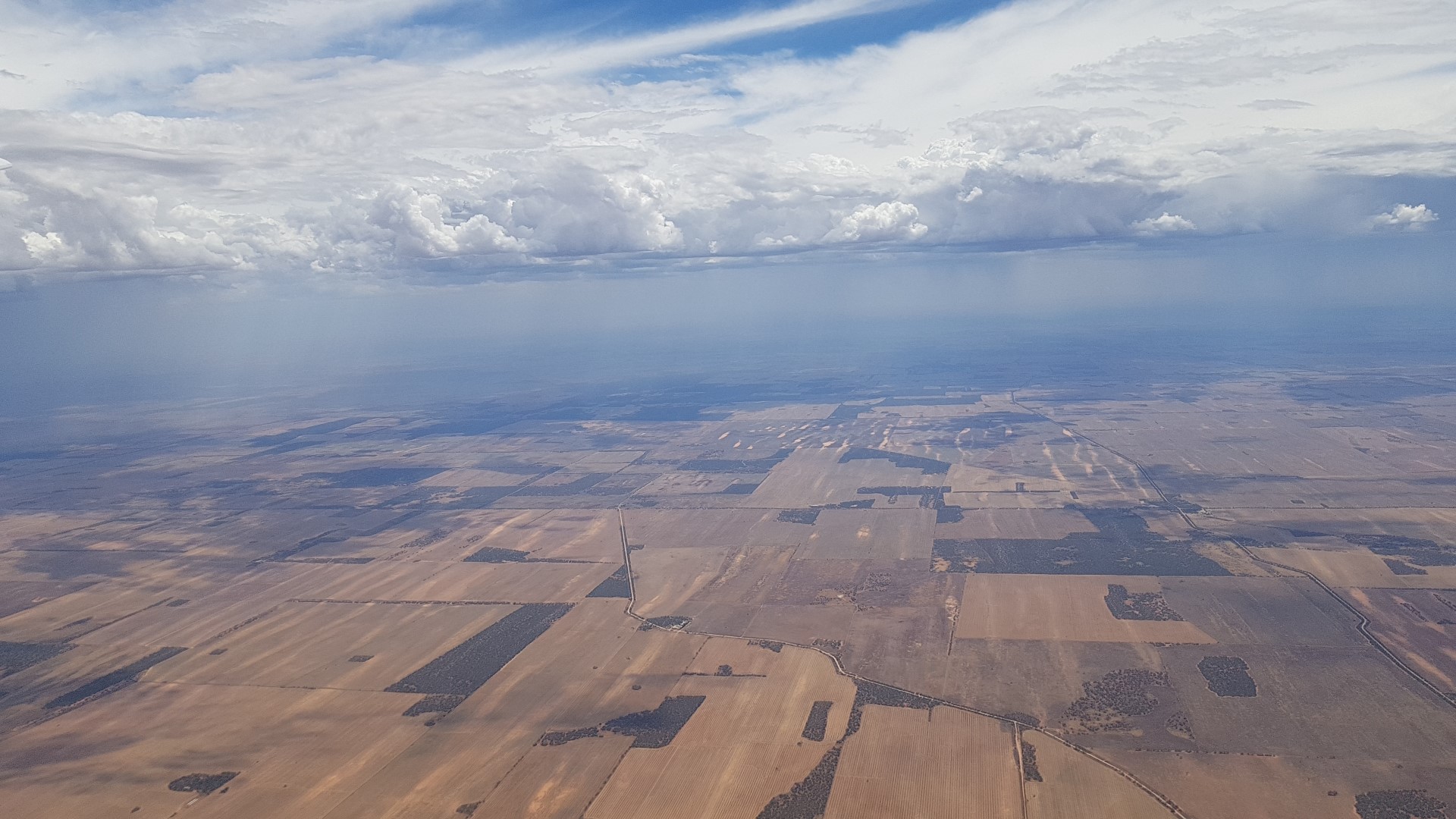
After running with much of the field to the western edge of the trough I turned
east a little north of Steinfeld, and took a path aiming to intersect the Meribah
circle at its north eastern extremity. There were good clouds a little short of the
Murray and I thought that I could get a couple of good climbs fly across the
southern edge of the flooded area, stay connected with the clouds, touch the
north eastern edge of the Meribah circle and then home.
Well……..the clouds started dying as I reached them one after the other, I had to
swing well south to some ragged looking stuff to avoid the blue hole over the
flood, struggled in rubbishing lift and finally headed for home looking at the dust
front approaching from the south west. Bill was advising of the deteriorating
conditions as we approaching Waikerie, so we knew what we were in for. I
carried a lot of excess height, flew into the front the front a bit short of the
airfield and landed into a strong, gusty, dusty south-westerly. The folk on the
ground were quick to help and David Jones was soon at my cockpit to assist. In
the end Bernie Sizer was the only victim of some treacherous sink and he
skilfully managed to land in the paddock just short of runway 26, having finished
above minimum finish height.
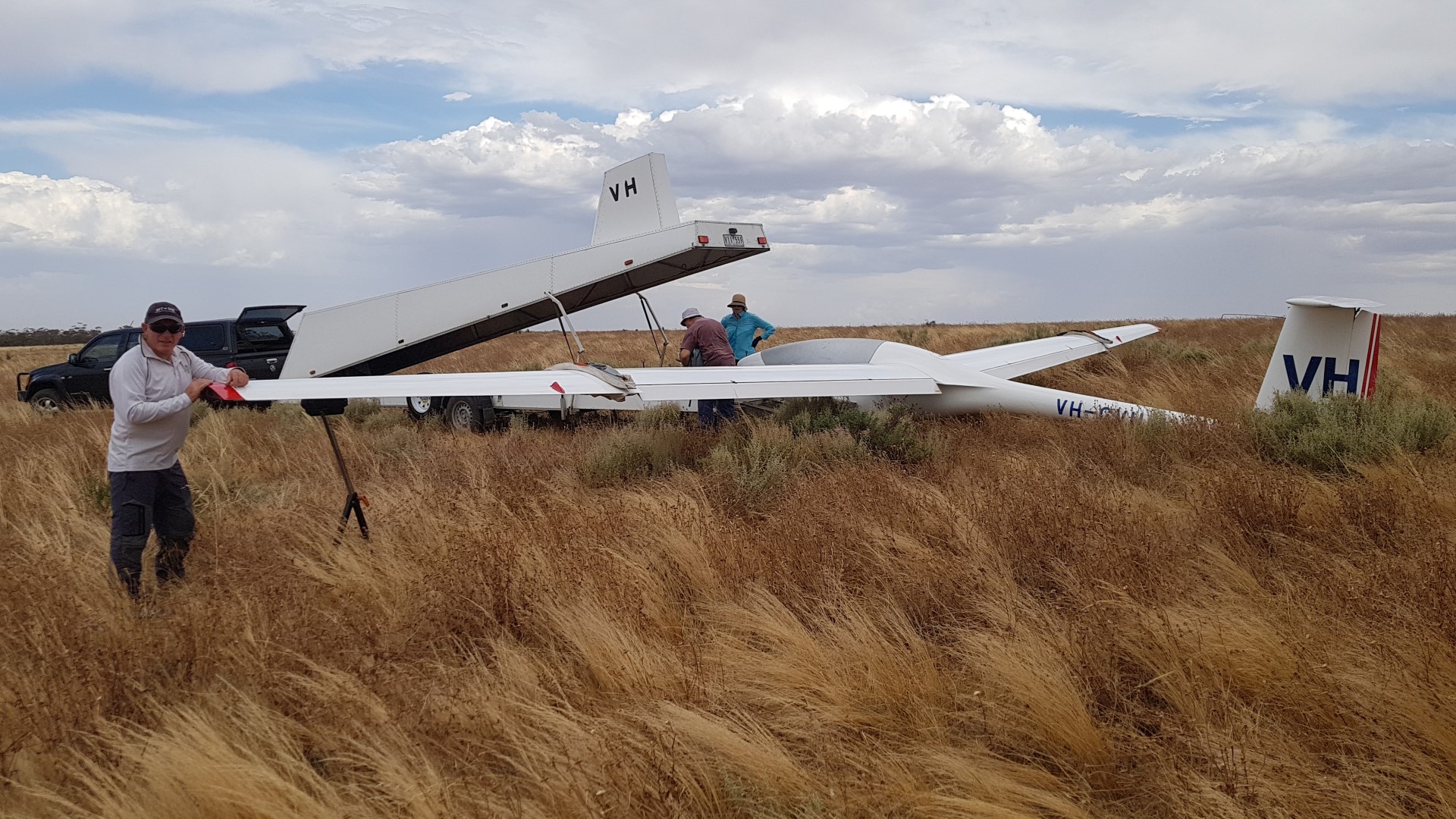
Some might recall an almost identical situation at the Waikerie Nationals in
2015, when a vigorous front, possibly more severe than this one, came through
as we were finishing the race.
I said earlier that I should have paid more attention to Skysight, and in addition I
should thought more about the picture that I could see after I turned to head
east. The convergence associated with the trough actually arced around to the
south east provided an energy line in the direction of the southern edge of the
Meribah circle. Craig, being smarter than the average bear, did just that and
blitzed everyone, achieving a superb 157kph against my pitiful 130. Well flown
Craig.
Skipping to Day 7, the last day.: Forecast was very promising and a 500+km task
was set. The day got off to a slow start so when the task A launch criteria was
passed, Mandy reverted to task B, a 380km task. South to Copeville, east to
Peebinga, north to Lindsay River and home via Loxton and Woolpunda. At
revised launch time the first wisps were appearing and soon we had a beautiful
sky of cumulus. Amongst the front-runners there was a bit of gamesmanship
regarding starting time but by then the rest of us were on our way. The
conditions were pretty fast but along the second leg, whilst following an energy
line slightly right of track, I seemed to be missing all the good climbs and had slid
down from around 7,000ft towards 3,000 ft heading into the scrub, rejecting the
2-4 kt climbs looking for better. It had the feeling of a trap if I pushed on so I
took the next bit of rising air and wormed my way around, accepting that this
might take a little time and was rewarded with a climb that started off a little
slow, and if I was higher it would have been rejected, but it got better and better
until it was a ripper. This turned out, I suspect, to be one of my better (lucky)
decisions since Adam Wooley, who was leading the contest at the time, found
himself in a not too different a situation in the exact same area, missing the
climbs, and unfortunately got very low and had a torrid time bouncing off 1,000ft
for about 30 minutes which cost him the championships.
At the Peebinga turn I was joined by Bruce Taylor in his ASG29 and we had a
wonderful romp around the rest of the course and a fast run home. Foolishly I
took a couple of unnecessary turns just out of Loxton and Bruce slipped ahead
and over the finish line 1minute17seconds ahead. Silly old me!!
After landing those with LX9000 and similar were able to submit their logs direct
from the cockpit but the rest of us submitted our logs via a very user friendly
interface using our laptops. Thanks to Adam Howell assisted by Neil Campbell
who oversaw the scoring to ensure that we all correctly completed the race in
accordance with the rules or maybe penalised for any misdemeanours. A couple
of us got warnings for PEV related issues but there were no actual points
penalties in the Open Class and only one minor infringement in the Sports Class
As mentioned earlier, evening meals in the Clubhouse were superbly catered by
Jason and Sandy Goldup on most nights, with regular help from Sid Nankivell’s
partner Lyn Spencer-Cole. Our Rod vdB took over as Le chef of the kitchen on
one night in Jason and Sandy’s absence. Thank you all. It was quite wonderful to
be able to tell tall stories with the entire team of participants, officials,
supporters and helpers, and for those so inclined, joining Craig’s ‘Wine Club’
drinking superb tipples with the ‘membership’ charges being donated directly to
the club. Thank you Craig. In addition to Craig, John Spronk. Rodney van den
Brink and Patrick Dunn kept the bar operating. And we mustn’t forget Doug and
Gale Forbes who continued to keep the clubhouse and facilities in pristine
condition.
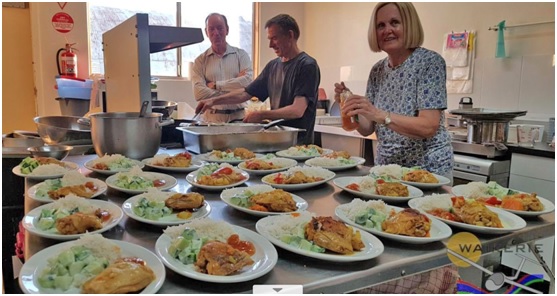
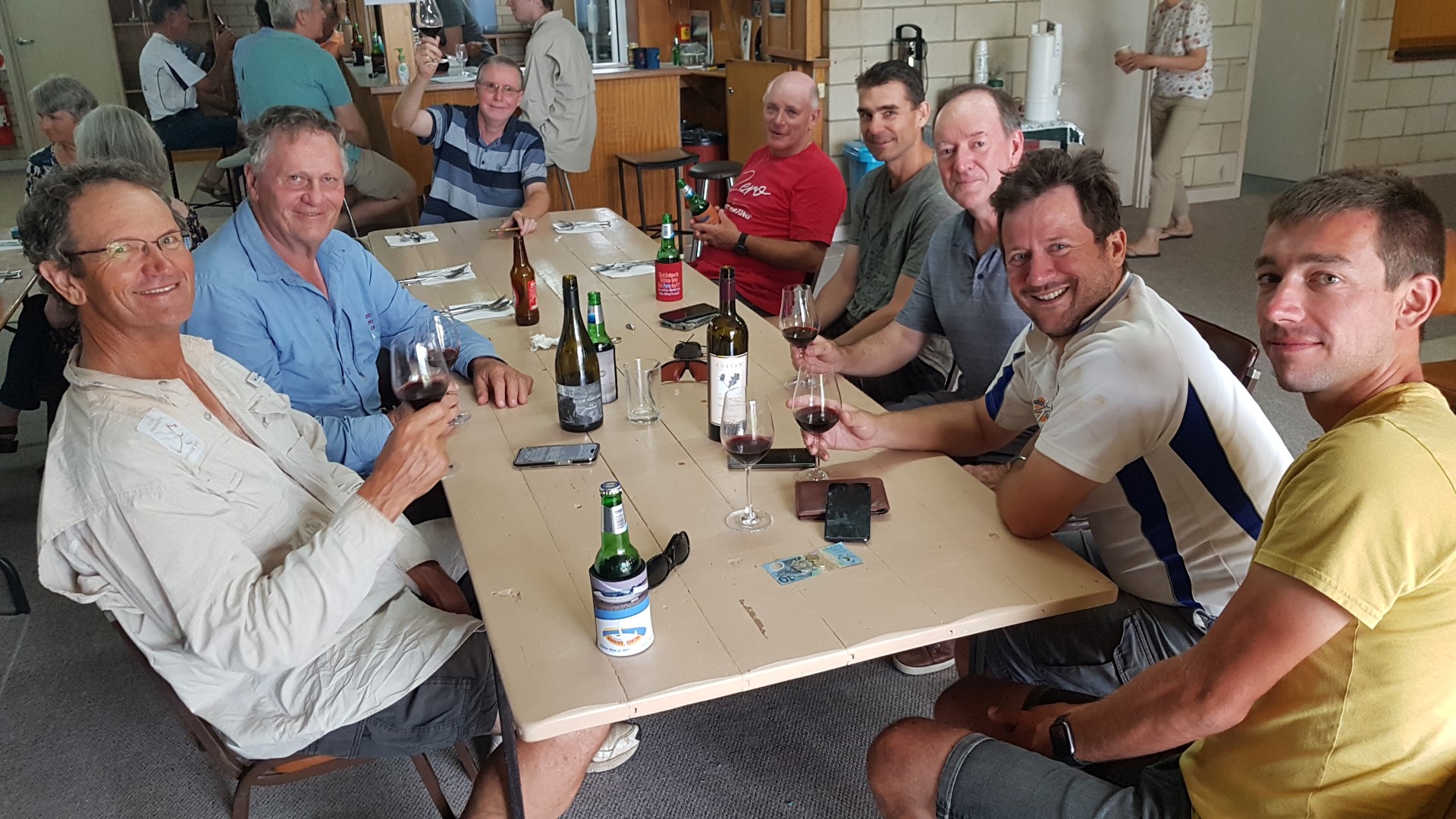
Air Pilot, Craig Vinall, Adam Wooley, Desert Air pilot)
Eventually all good things come to an end. Mathew Scutter was champion in the
Open/18 Meter class and our own David Collins in the mighty ASW20 was a
pretty clear winner in the Sports Class. Our Rodney van den Brink, after his
initial misgivings, had a great time and acquitted himself most honourably in his
first national championship.
We were privileged to have Malcolm Jinks, many times national champion and
world championship pilot, present the prizes at the wind up and awards dinner.
(I think Malcolm would still teach us a thing or two about glider racing!!)
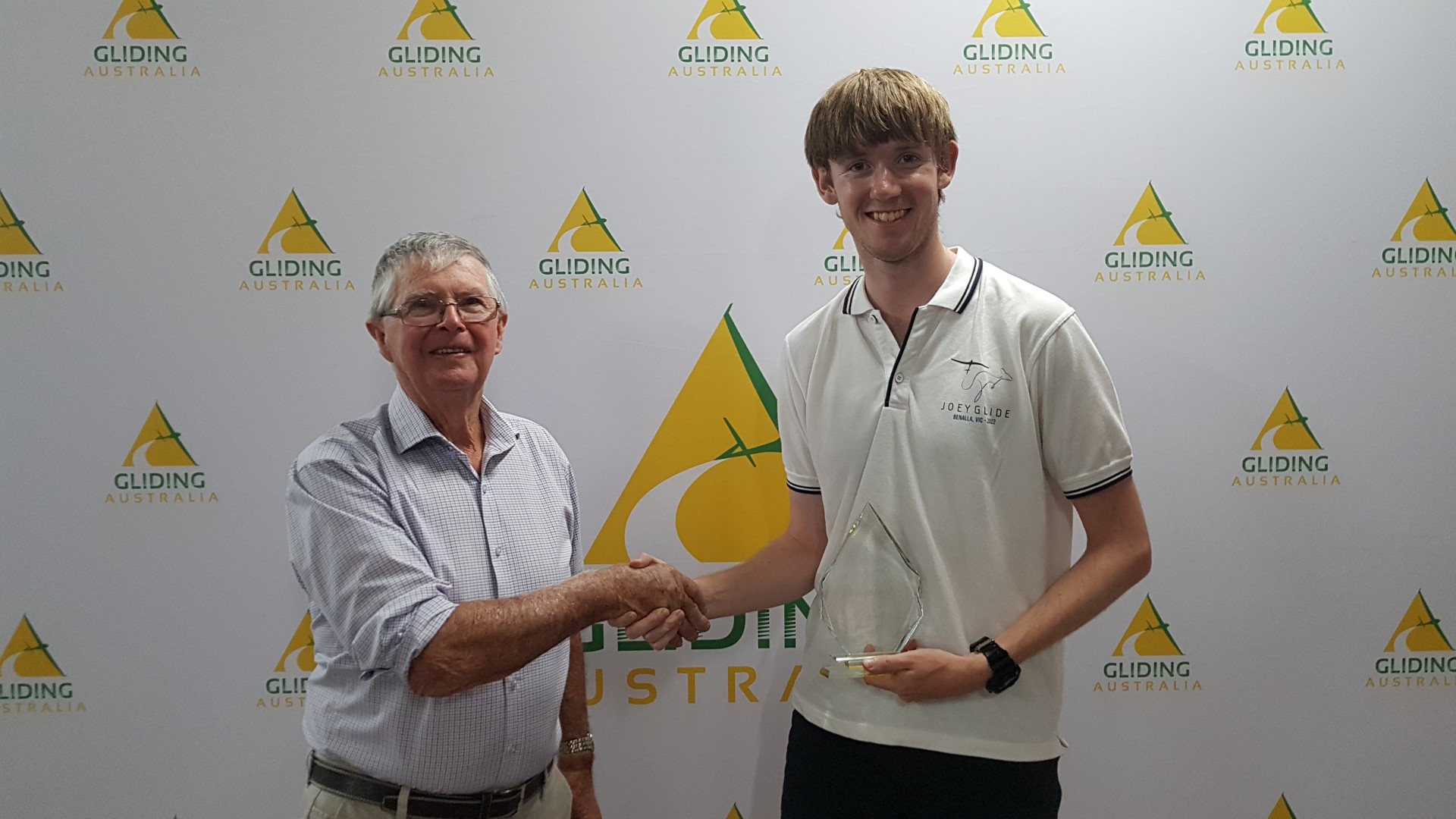
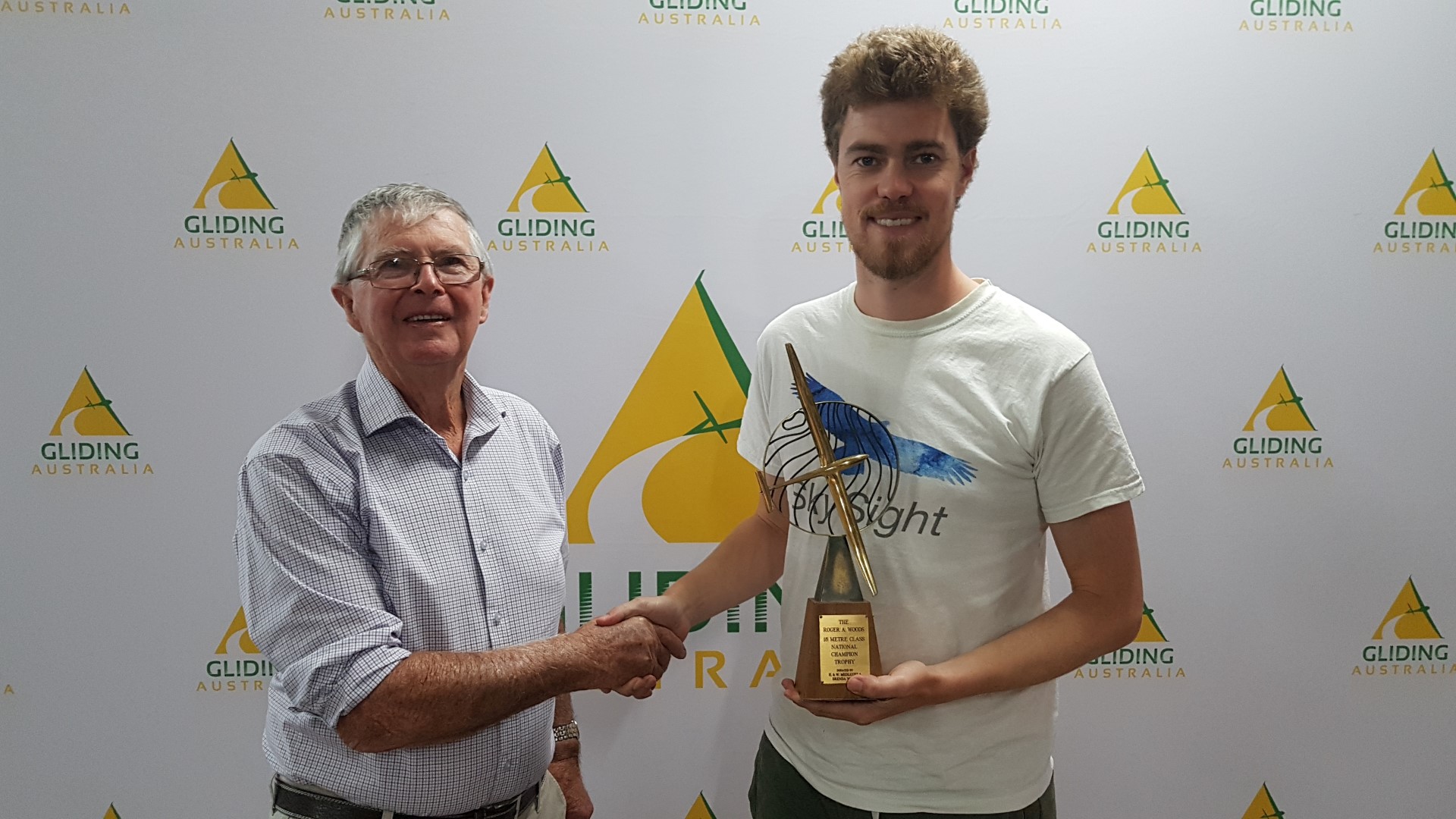
Finally, again a great big thank you to the folk who volunteered to make this a great contest. I have tried to mention all the helpers but to any I have missed –
my apologies – I’ll blame in old age and senility.
David Pietsch
